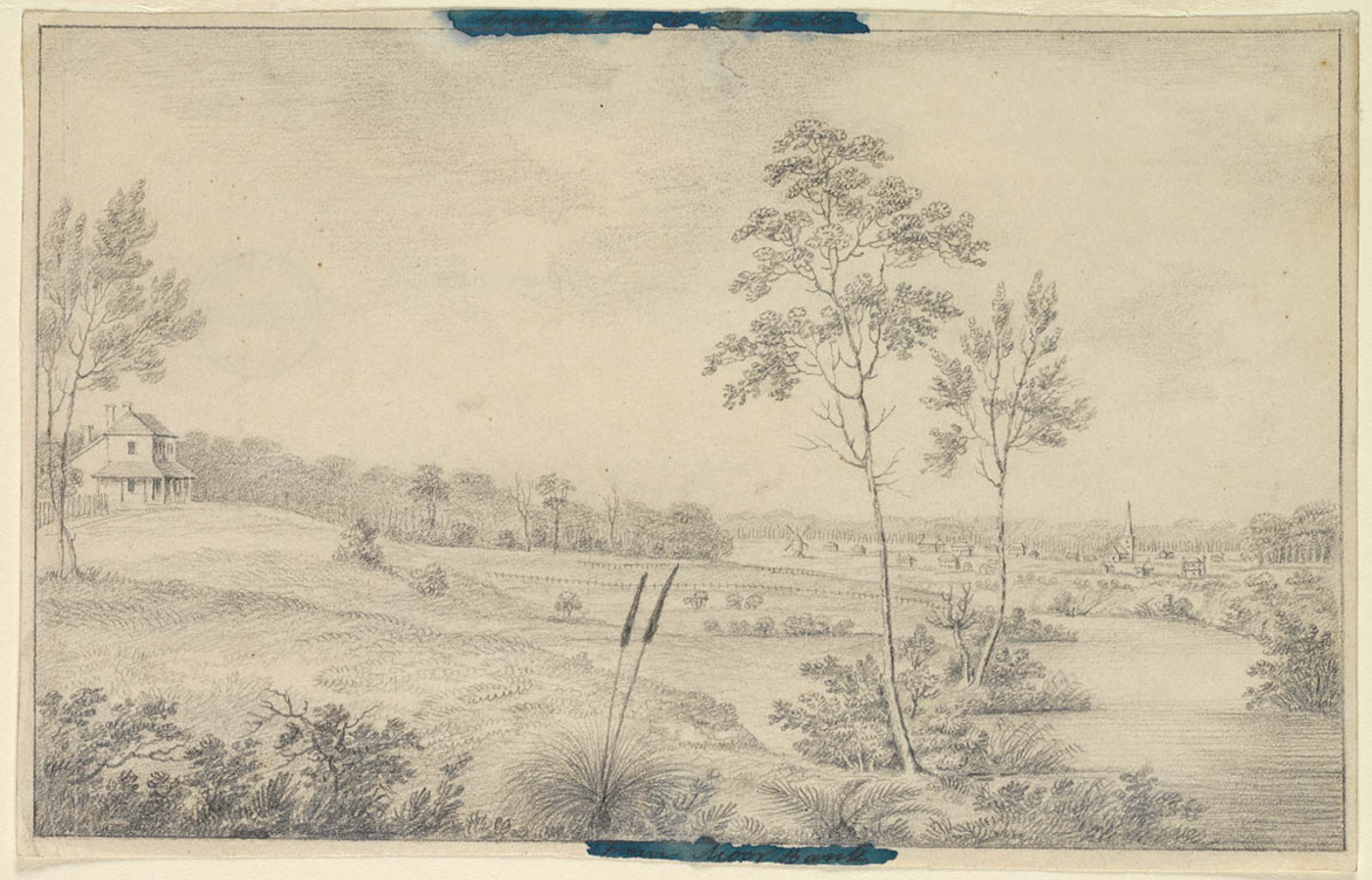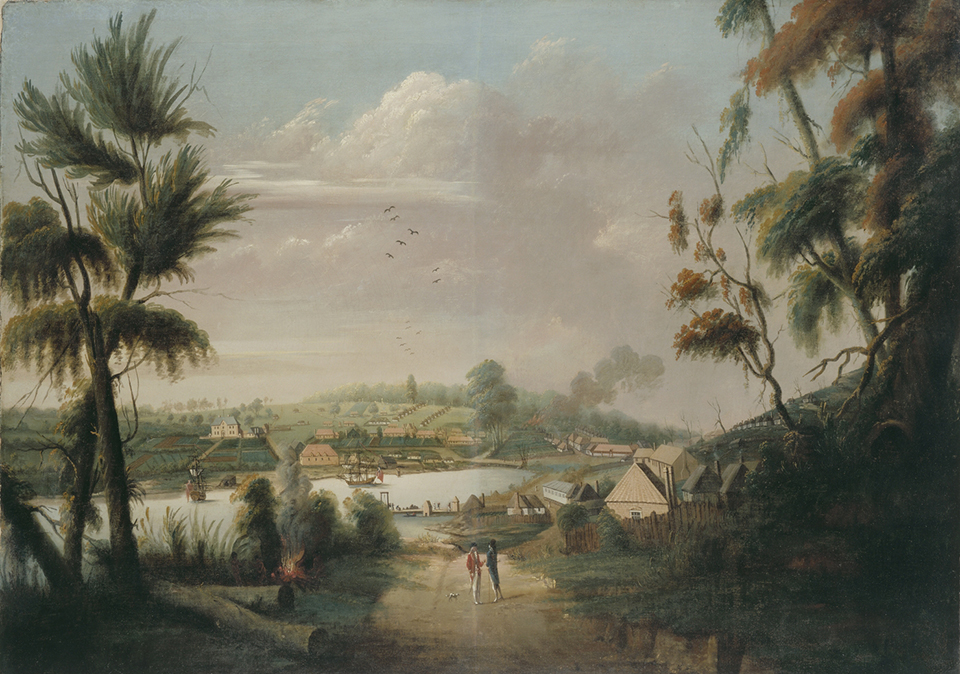The Dictionary of Sydney was archived in 2021.
Lady Juliana
Citation
Persistent URL for this entry
To cite this entry in text
To cite this entry in a Wikipedia footnote citation
To cite this entry as a Wikipedia External link
Lady Juliana
[media]As the first exclusively female convict transport to Australia, the voyage of Lady Juliana is of great historical significance. Lady Juliana was also the first convict transport to arrive in Australia after the First Fleet and the only transport of the Second Fleet not to have been chartered by slave traders Camden, Calvert & King.
In October 1788, Home Secretary Lord Sydney informed the Treasury that he wanted to send at least 200 female convicts to New South Wales. By mid-November, William Richards junior, a London shipbroker who had chartered several ships of the First Fleet, was contracted to provide a ship and transport the women.
The 401-ton barque, Lady Juliana, built at Whitby in 1769,[1] was surveyed at the Navy's Deptford Dockyard in late November and approved for use. By mid-December the crew was engaged and master, George Aitken appointed.[2] Also on board for the journey to Australia were surgeon Richard Alley and Lieutenant Thomas Edgar who had sailed as master of Discovery during Cook's final voyage.[3] Edgar, as naval agent, had responsibility to ensure the terms of the contract between the government and the shipping agent were observed. Steward John Nicol,[media] whose 1822 autobiography is the main source of information for the voyage of Lady Juliana, described Edgar as a 'decent, kindly man'.[4] Indeed, the low mortality rate of Lady Juliana, when compared to the disastrous levels on the other three transports of the Second Fleet, seems to confirm Edgar's reasonable treatment of his convict charges.
The voyage of Lady Juliana to New South Wales was beset with delays from the beginning. Prior to departure, the vessel remained for six months in the Thames, during which time Nicol claimed that 'all the jails in England were [being] emptied to complete the cargo of the Lady Juliana'.[5] In addition to the convicts, large supplies of cloth and clothing were loaded on board.[6]
On 29 July 1789 Lady Juliana finally set sail from Plymouth, more than seven months after being hired as a transport and with over 220 female convicts onboard. [7] Included in their number were Eleanor Higgins, who became an early settler of the Epping area, Elizabeth Steel, the first recorded deaf Australian, [8] and Rachel Turner, a convict who rose to prominence and wealth in the colony with her husband Thomas Moore and from whose property [media]the Sydney suburb of Moorebank derives its name. [9] Also onboard was Mary Wade – convicted for the crime of highway robbery and, at around 11 years old, one of the youngest convicts to embark. [10] At the time of Wade's death, she allegedly had over three hundred living descendants and today, her descendants number in the tens of thousands and include former Prime Minster Kevin Rudd.[11]
On 21 September 1789 the ship called briefly at Tenerife, where the agent certified there were 226 women and six children on board. In his memoirs, Nicol recalled that four women escaped here.[12] Nicol also described in detail the conditions on board, where the women were allowed to move freely and fraternisation between crew and convicts was not discouraged:
When we were fairly out at sea, every man on board took a wife from among the convicts, they nothing loath.[13]
Nicol himself developed a relationship with one of the convict women, Sarah Whitlam, and ship's surgeon Richard Alley partnered with the convict Ann Mash, who was transported for the theft of a bushel of wheat. Mash went on to lead a relatively prosperous life in Sydney as a businesswoman, operating as a shopkeeper, publican and operator of one of the early passenger boat services between Parramatta and Sydney.[14]
As the voyage approached the equator, the weather became increasingly hot and many fell ill, however the overall health of the female convicts remained good.[15]
At the next stop, Rio de Janeiro, Lady Juliana remained seven weeks. By the time the ship arrived at the Cape of Good Hope, the Second Fleet storeship HMS Guardian had been beached [media]and abandoned. Guardian had struck an iceberg, sustaining significant damage, and after a perilous journey returned to the Cape where the remaining stores were salvaged. Lady Juliana stayed one month at the Cape of Good Hope, taking on additional provisions and five men who had been dispatched on the Guardian to work as superintendents in NSW.[16]
Arrival
On 3 June 1790, Lady Juliana reached Port Jackson after a voyage of 309 days, [17] however poor weather delayed the ship's anchoring in Sydney Cove until 6 June. [18] Two hundred and twenty-two women were landed on 11 June,[19] and only five deaths had occurred in the nearly 10 months of the voyage. Edgar had ensured that rations were properly issued and [media]that the ship was regularly cleaned and fumigated. Long stays in port stops and the convicts' free access to the deck was also likely to have been an additional factor in the low mortality rate.[20]
As the first new arrival since the founding of the colony, Lady Juliana's presence brought mixed blessings to the isolated settlement. The ship conveyed news, including King George III's illness and recovery from porphyria, George Washington's inauguration as the first president of the United States, [21] and the misfortunes of the Second Fleet storeship, Guardian. To the colony, already on reduced rations, the loss of the storeship was a blow and the arrival of Lady Juliana, with more than 200 additional mouths to feed, promised to stretch the settlement's meagre resources even further.
Many of Lady Juliana's convict women were soon sent on to the colony at Norfolk Island. Only one of their voices remains in the historical record, an anonymous letter published in 1791 that confirms the good treatment reflected in Nicol's account:
We arrived here safe after a long voyage, in very good health…as we had everything that we could expect from them, and all our provisions were good.
While the ship has been referred to as a 'nothing more than a floating brothel,' [22] this denies the individuality and agency of the convict women in the relationships that developed and the privileges those connections afforded.[23] Nicol's account suggests that the women were not coerced and that during the voyage they enjoyed the freedom to move around the ship, fraternise with crew and even wear their own clothes.[24]
Return journey
Lady Juliana underwent considerable repairs before attempting the return voyage to England. The vessel sailed for Canton on 25 July 1790 to take on a cargo of tea for the East India Company and joined a convoy of British East India Company ships for the homeward voyage. Along with Second Fleet transports Neptune and Scarborough and storeship Justinian, Lady Juliana returned to England in early October 1791. [25] On 14 December 1791 Lady Juliana, moored at Greenland dock, was offered for auction at the New Lloyds Coffee House above the Royal London Exchange. [26]
Further reading
Bateson, Charles. The Convict Ships, 1787–1868. Glasgow: Brown, Son & Ferguson, 1969.
Collins, David. An Account of the English Colony in New South Wales; With Remarks on the Dispositions, Customs, Manners &c. of the Native Inhabitants of that Country, volume III, 1798, edited by H Fletcher. Sydney: AH & AW Reed in association with the Royal Australian Historical Society, 1975.
Flynn, Michael. The Second Fleet: Britain's Grim Convict Armada of 1790. Sydney: Library of Australian History, 2001.
Rees, Siân. The Floating Brothel: The Extraordinary Story of the Lady Julian and its Cargo of Female Convicts Bound for Botany Bay. Sydney: Hodder Headline Australia, 2001.
Notes
[1] Lloyd's Register 1780 (London: The Gregg Press)
[2] Michael Flynn, The Second Fleet: Britain's Grim Convict Armada of 1790 (Sydney: Library of Australian History, 2001), 16
[3] Siân Rees, The Floating Brothel: the extraordinary story of the Lady Julian and its cargo of female convicts bound for Botany Bay (Sydney: Hodder Headline Australia, 2001), 60-62
[4] Siân Rees, The Floating Brothel: The Extraordinary Story of the Lady Julian and its Cargo of Female Convicts Bound for Botany Bay (Sydney: Hodder Headline Australia, 2001), 61
[5] Extract from The Life and Adventures of John Nicol, Mariner (Edinburgh, 1822) in The Second Fleet Convicts edited by R Ryan (Sydney: Australian Documents Library, 1982), 81
[6] Michael Flynn, The Second Fleet: Britain's Grim Convict Armada of 1790 (Sydney: Library of Australian History, 2001), 19
[7] Michael Flynn, The Second Fleet: Britain's Grim Convict Armada of 1790 (Library of Australian History Sydney, 2001), 17
[8] Jan Branson and Don Miller, The Story of Betty Steel: Deaf Convict and Pioneer (Petersham, NSW: Deafness Resources Australia, 1995)
[9] Michael Flynn, The Second Fleet: Britain's Grim Convict Armada of 1790 (Sydney: Library of Australian History, 2001), 103–4
[10] Trial of Mary Wade, Jane Whiting’, 14 January 1789, t17890114-58, Old Bailey Proceedings Online, www.oldbaileyonline.org, viewed 18 February 2016
[11] Robert Macklin, Kevin Rudd: The Biography, (Camberwell, Victoria: Penguin Group, 2007), https://www.penguin.com.au/products/9780670072378/kevin-rudd-biography/40993/extract, viewed 18 February 2016
[12] Michael Flynn, The Second Fleet: Britain's Grim Convict Armada of 1790 (Sydney: Library of Australian History, 2001), 18
[13] Extract from The Life and Adventures of John Nicol, mariner, in The Second Fleet Convicts edited by R Ryan (Sydney: Australian Documents Library, 1982), 84
[14] Michael Flynn, The Second Fleet: Britain's Grim Convict Armada of 1790 (Sydney: Library of Australian History, 2001), 103
[15] Michael Flynn, The Second Fleet: Britain's Grim Convict Armada of 1790 (Sydney: Library of Australian History, 2001), 18
[16] David Collins, An Account of the English Colony in New South Wales; With Remarks on the Dispositions, Customs, Manners &c. of the Native Inhabitants of that Country, volume III, 1798, edited by H Fletcher (Sydney: AH & AW Reed in association with the Royal Australian Historical Society, 1975), 125
[17] Charles Bateson, The Convict Ships, 1787–1868 (Glasgow: Brown, Son & Ferguson, 1969), 121
[18] David Collins, An Account of the English Colony in New South Wales; With Remarks on the Dispositions, Customs, Manners &c. of the Native Inhabitants of that Country, volume III, 1798, edited by H Fletcher (Sydney: AH & AW Reed in association with the Royal Australian Historical Society, 1975)
[19] David Collins, An Account of the English Colony in New South Wales; With Remarks on the Dispositions, Customs, Manners &c. of the Native Inhabitants of that Country, volume III, 1798, edited by H Fletcher (Sydney: AH & AW Reed in association with the Royal Australian Historical Society, 1975), 127
[20] Charles Bateson, The Convict Ships, 1787–1868 (Glasgow: Brown, Son & Ferguson, 1969), 123
[21] Robert Hughes, The Fatal Shore: A History of the Transportation of Convicts to Australia, 1787–1868 (Guild Publishing London, 1987), 104
[22] Charles Bateson, The Convict Ships, 1787–1868 (Glasgow: Brown, Son & Ferguson, 1969), 106
[23] Siân Rees, The Floating Brothel: the extraordinary story of the Lady Julian and its cargo of female convicts bound for Botany Bay (Sydney: Hodder Headline Australia, 2001), 217
[24] Michael Flynn, The Second Fleet: Britain's Grim Convict Armada of 1790 (Sydney: Library of Australian History, 2001), 18
[25] Northampton Mercury, Saturday 8 October 1791, 1
[26] Michael Flynn, The Second Fleet: Britain's Grim Convict Armada of 1790 (Sydney: Library of Australian History, 2001), 22
.







